Paradoxical role of reactive oxygen species in bone remodelling: implications in osteoporosis and possible nanotherapeutic interventions
Osteoporosis is a metabolic bone disorder that affects both sexes and is the most common cause of fractures. Osteoporosis therapies primarily inhibit osteoclast activity, and are seldom designed to
[...] Read more.
Osteoporosis is a metabolic bone disorder that affects both sexes and is the most common cause of fractures. Osteoporosis therapies primarily inhibit osteoclast activity, and are seldom designed to trigger new bone growth thereby frequently causing severe systemic adverse effects. Physiologically, the intracellular redox state depends on the ratio of pro-oxidants, oxidizing agents (reactive oxygen species, ROS) and antioxidants. ROS is the key contributor to oxidative stress in osteoporosis as changes in redox state are responsible for dynamic bone remodeling and bone regeneration. Imbalances in ROS generation vs. antioxidant systems play a pivotal role in pathogenesis of osteoporosis, stimulating osteoblasts and osteocytes towards osteoclastogenesis. ROS prevents mineralization and osteogenesis, causing increased turnover of bone loss. Alternatively, antioxidants either directly or indirectly, contribute to activation of osteoblasts leading to differentiation and mineralization, thereby reducing osteoclastogenesis. Owing to the unpredictability of immune responsiveness and reported adverse effects, despite promising outcomes from drugs against oxidative stress, treatment in clinics targeting osteoclast has been limited. Nanotechnology-mediated interventions have gained remarkable superiority over other treatment modalities in regenerative medicine. Nanotherapeutic approaches exploit the antioxidant properties of nanoparticles for targeted drug delivery to trigger bone repair, by enhancing their osteogenic and anti-osteoclastogenic potentials to influence the biocompatibility, mechanical properties and osteoinductivity. Therefore, exploiting nanotherapeutics for maintaining the differentiation and proliferation of osteoblasts and osteoclasts is quintessential.
Largee Biswas ... Anita Kamra Verma
Osteoporosis is a metabolic bone disorder that affects both sexes and is the most common cause of fractures. Osteoporosis therapies primarily inhibit osteoclast activity, and are seldom designed to trigger new bone growth thereby frequently causing severe systemic adverse effects. Physiologically, the intracellular redox state depends on the ratio of pro-oxidants, oxidizing agents (reactive oxygen species, ROS) and antioxidants. ROS is the key contributor to oxidative stress in osteoporosis as changes in redox state are responsible for dynamic bone remodeling and bone regeneration. Imbalances in ROS generation vs. antioxidant systems play a pivotal role in pathogenesis of osteoporosis, stimulating osteoblasts and osteocytes towards osteoclastogenesis. ROS prevents mineralization and osteogenesis, causing increased turnover of bone loss. Alternatively, antioxidants either directly or indirectly, contribute to activation of osteoblasts leading to differentiation and mineralization, thereby reducing osteoclastogenesis. Owing to the unpredictability of immune responsiveness and reported adverse effects, despite promising outcomes from drugs against oxidative stress, treatment in clinics targeting osteoclast has been limited. Nanotechnology-mediated interventions have gained remarkable superiority over other treatment modalities in regenerative medicine. Nanotherapeutic approaches exploit the antioxidant properties of nanoparticles for targeted drug delivery to trigger bone repair, by enhancing their osteogenic and anti-osteoclastogenic potentials to influence the biocompatibility, mechanical properties and osteoinductivity. Therefore, exploiting nanotherapeutics for maintaining the differentiation and proliferation of osteoblasts and osteoclasts is quintessential.
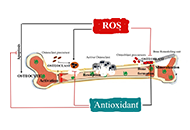 Paradoxical role of reactive oxygen species in bone remodelling: implications in osteoporosis and possible nanotherapeutic interventionsOpen AccessReviewOsteoporosis is a metabolic bone disorder that affects both sexes and is the most common cause of fractures. Osteoporosis therapies primarily inhibit osteoclast activity, and are seldom designed to [...] Read more.Largee Biswas ... Anita Kamra VermaPublished: August 31, 2022 Explor Med. 2022;3:393–413
Paradoxical role of reactive oxygen species in bone remodelling: implications in osteoporosis and possible nanotherapeutic interventionsOpen AccessReviewOsteoporosis is a metabolic bone disorder that affects both sexes and is the most common cause of fractures. Osteoporosis therapies primarily inhibit osteoclast activity, and are seldom designed to [...] Read more.Largee Biswas ... Anita Kamra VermaPublished: August 31, 2022 Explor Med. 2022;3:393–413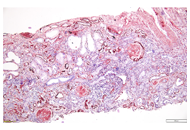 A case report: 19-year-old male diagnosed with C1q nephropathy requiring renal replacement therapyOpen AccessCase ReportC1q nephropathy is a rare glomerular disease. Clinical presentation is diverse and ranges from asymptomatic hematuria or proteinuria to symptoms and signs of nephrotic/nephritic syndrome. On light microscopy, it can be classified [...] Read more.Randa Choueiri ... Vanessa NseirPublished: August 31, 2022 Explor Med. 2022;3:386–392
A case report: 19-year-old male diagnosed with C1q nephropathy requiring renal replacement therapyOpen AccessCase ReportC1q nephropathy is a rare glomerular disease. Clinical presentation is diverse and ranges from asymptomatic hematuria or proteinuria to symptoms and signs of nephrotic/nephritic syndrome. On light microscopy, it can be classified [...] Read more.Randa Choueiri ... Vanessa NseirPublished: August 31, 2022 Explor Med. 2022;3:386–392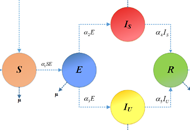 Mathematical model for transmission of Chlamydia due to sexual activity and unhygienic environmentOpen AccessOriginal ArticleAim: Sexually transmitted diseases (STDs) need to be studied systematically to better understand their global spread. Transmission of Chlamydia trachomatis is a severe public health issue, with r [...] Read more.Nita H. Shah ... Yash N. ShahPublished: August 30, 2022 Explor Med. 2022;3:375–385
Mathematical model for transmission of Chlamydia due to sexual activity and unhygienic environmentOpen AccessOriginal ArticleAim: Sexually transmitted diseases (STDs) need to be studied systematically to better understand their global spread. Transmission of Chlamydia trachomatis is a severe public health issue, with r [...] Read more.Nita H. Shah ... Yash N. ShahPublished: August 30, 2022 Explor Med. 2022;3:375–385 Is there any correlation between muscle fatigue and serum lactate dehydrogenase levels in prediabetic individuals?Open AccessOriginal ArticleAim: Lactate dehydrogenase (LDH) is an enzyme that acts as a catalyst in the conversion of lactate to pyruvate which is abundantly found in liver, kidney, heart and muscles. Previous studies have all shown a strong positive correl [...] Read more.Charu Mishra ... Ranjan Kumar DixitPublished: August 29, 2022 Explor Med. 2022;3:368–374
Is there any correlation between muscle fatigue and serum lactate dehydrogenase levels in prediabetic individuals?Open AccessOriginal ArticleAim: Lactate dehydrogenase (LDH) is an enzyme that acts as a catalyst in the conversion of lactate to pyruvate which is abundantly found in liver, kidney, heart and muscles. Previous studies have all shown a strong positive correl [...] Read more.Charu Mishra ... Ranjan Kumar DixitPublished: August 29, 2022 Explor Med. 2022;3:368–374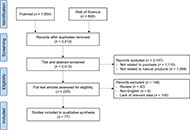 Signaling pathways and targets of natural products in psoriasis treatmentOpen AccessSystematic ReviewAim: Psoriasis is a common chronic inflammatory skin disorder, which has adverse effects on patients’ quality of life. Natural products exhibit significant therapeutic capacities with [...] Read more.Ly Thi Huong NguyenPublished: August 29, 2022 Explor Med. 2022;3:345–367
Signaling pathways and targets of natural products in psoriasis treatmentOpen AccessSystematic ReviewAim: Psoriasis is a common chronic inflammatory skin disorder, which has adverse effects on patients’ quality of life. Natural products exhibit significant therapeutic capacities with [...] Read more.Ly Thi Huong NguyenPublished: August 29, 2022 Explor Med. 2022;3:345–367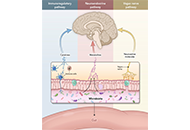 Feed your microbiome and improve sleep, stress resilience, and cognitionOpen AccessReviewThe brain and gut are connected both physically and biochemically. The gut-brain axis includes the central nervous system, neuroendocrine and neuroimmune systems, the enteric nervous system and vagu [...] Read more.Maciej Chichlowski ... Neeraj PandeyPublished: August 29, 2022 Explor Med. 2022;3:331–344
Feed your microbiome and improve sleep, stress resilience, and cognitionOpen AccessReviewThe brain and gut are connected both physically and biochemically. The gut-brain axis includes the central nervous system, neuroendocrine and neuroimmune systems, the enteric nervous system and vagu [...] Read more.Maciej Chichlowski ... Neeraj PandeyPublished: August 29, 2022 Explor Med. 2022;3:331–344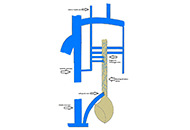 Downhill esophageal varices: a systematic review of the case reportsOpen AccessSystematic ReviewAim: The etiologies, presentation, and management of downhill varices in the era of modern medicine are relatively under-explored and mostly limited to case reports or case series. Methods: P [...] Read more.Hassam Ali ... Devika KapuriaPublished: August 11, 2022 Explor Med. 2022;3:317–330
Downhill esophageal varices: a systematic review of the case reportsOpen AccessSystematic ReviewAim: The etiologies, presentation, and management of downhill varices in the era of modern medicine are relatively under-explored and mostly limited to case reports or case series. Methods: P [...] Read more.Hassam Ali ... Devika KapuriaPublished: August 11, 2022 Explor Med. 2022;3:317–330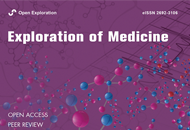 Adenine-rich diet: a potential mechanism for renal fibrosis progressionOpen AccessLetter to the EditorChronic kidney disease (CKD) is a major health problem but there are many modalities to prevent and manage CKD progression. Diet is one of these factors, which needs to be evaluated more. Adenine is a water-soluble nucleoprotein t [...] Read more.Majid MalakiPublished: July 25, 2022 Explor Med. 2022;3:314–316
Adenine-rich diet: a potential mechanism for renal fibrosis progressionOpen AccessLetter to the EditorChronic kidney disease (CKD) is a major health problem but there are many modalities to prevent and manage CKD progression. Diet is one of these factors, which needs to be evaluated more. Adenine is a water-soluble nucleoprotein t [...] Read more.Majid MalakiPublished: July 25, 2022 Explor Med. 2022;3:314–316